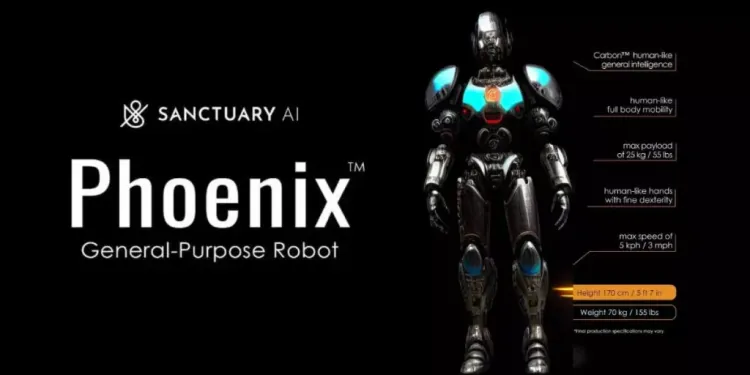Phoenix Robot: Revolutionizing Speed in Robotics
Phoenix Robot: Revolutionizing Speed in Robotics

The Revolutionary Step in Robotics: Sanctuary's Phoenix – The Speedy Humanoid Transforming Automation
Discover the breakthrough in robotics with Sanctuary's Phoenix, featuring the world's most advanced robot hands, operating autonomously at unparalleled speeds. A monumental leap in technology, redefining the future of robotics.
The realm of humanoid robotics has witnessed an extraordinary breakthrough with the introduction of Sanctuary's Phoenix, a bot that marks a significant step change in the field. Unlike the humanoid robots we've grown accustomed to, Phoenix stands out with its unparalleled speed and the "world's best robot hands," functioning entirely autonomously. This Canadian marvel, birthed by Sanctuary AI, is not just a leap but a sprint forward in the quest for general-purpose humanoids, employing a blend of teleoperation and autonomous learning through simulation.
Sanctuary's Phoenix: A Unique Contender in Humanoid Robotics
Phoenix's journey is a captivating tale of innovation, where instead of walking, it glides on a wheeled platform. Yet, it boasts the most refined and human-like hands in the robotics domain, a testament to Sanctuary AI's focus on mastering work behaviors over locomotion. The bot's hands are not just about dexterity; they embody a perfect synthesis of precision, speed, and strength, thanks to their hydraulic actuation—a stark departure from the electric motors used by its peers like Optimus and Figure 01.
Unveiling the World's Best Robot Hands
The secret to Phoenix's exceptional capabilities lies in its hands, designed to perform with a finesse and power unmatched in the current landscape. Sanctuary's co-founder and CTO, Suzanne Gildert, sheds light on the intricate balance of features these hands offer. Unlike other robots that excel in a single aspect of hand movement, Phoenix's hydraulic hands deliver on all fronts, enabling it to execute tasks with a human-like ease and efficiency.
For an in-depth look into Sanctuary's innovative approach and Phoenix's capabilities, click here to explore more at Kiksee Magazine.
The Foundation of Movement: Learning from the Basics
Sanctuary's strategy in developing Phoenix's skills is remarkably methodical, focusing on the core movements akin to a baby discovering the world. This fundamental approach has led to the identification of "Eigengrasps," basic hand movements that are the building blocks for more complex tasks. By analyzing these movements through machine learning, the team aims to replicate the full spectrum of human hand capabilities, encompassing the 33 different grasps identified by medical professionals.
A Glimpse into the Future: Phoenix's Dynamic Progress
The fluidity and speed at which Phoenix operates are not just impressive; they signify a monumental shift in how we perceive robotic movement and capability. This humanoid's advanced learning algorithms promise a rapid expansion of its abilities, setting a new standard for autonomous robotics.
Embracing the Future with Sanctuary's Phoenix
As we stand on the brink of a new era in robotics, Phoenix by Sanctuary AI not only challenges our expectations but also opens a world of possibilities for automation and human-robot interaction. Its development journey, marked by a focus on the essentials of movement and the mastery of hand dexterity, showcases a forward-thinking approach that could redefine our future workforce.
Stay tuned for our full interview with Suzanne Gildert for an exclusive insight into the groundbreaking technology behind Phoenix and what lies ahead for Sanctuary AI.
For more fascinating updates and insights into the world of technology, don't forget to visit Kiksee Magazine, your prime source for the latest in innovation and tech news.
External Resources:
Discover More:
Summary: Sanctuary AI's latest marvel, the Phoenix humanoid robot, stands out in the robotics world with its exceptional hand dexterity and autonomous functionality. Unlike its contemporaries, Phoenix operates at near-human speeds, powered by uniquely designed hydraulic hands. This Canadian innovation focuses on mastering the basics of movement and grasping, offering a glimpse into the future of robotics where precision, strength, and speed converge seamlessly. Our in-depth conversation with co-founder Suzanne Gildert unveils the groundbreaking approach behind Phoenix's development and its implications for the future of robotics.
Conclusion
Sanctuary's Phoenix is not merely a technological marvel; it's a vision of what the future holds. With its unmatched speed, precision, and the world's best robot hands, Phoenix is setting new benchmarks in the field of robotics. As we continue to explore the capabilities and potential of humanoid robots, Phoenix stands as a beacon of innovation, guiding the way toward a future where robots and humans coexist and collaborate seamlessly. Stay updated with Kiksee Magazine for the latest breakthroughs in robotics and technology.
FAQs
What makes Sanctuary's Phoenix different from other humanoid robots? Sanctuary's Phoenix distinguishes itself with its highly advanced, hydraulically actuated hands, offering unmatched precision, speed, and strength, and its ability to perform tasks autonomously at near-human speeds.
How does Phoenix learn to perform tasks? Phoenix learns through a combination of teleoperation, where human operators show it how to perform tasks, and autonomous learning in simulation, allowing it to refine and expand its capabilities.
Why does Phoenix use a wheeled platform instead of walking? Sanctuary AI chose to focus on developing Phoenix's work behaviors and hand dexterity over locomotion, believing that mastering these aspects offers greater immediate value and utility.
What are Eigengrasps? Eigengrasps are basic hand movements identified through machine learning as the foundational movements from which more complex tasks can be performed. They are akin to the building blocks of all hand movements.
Can Phoenix's hands replicate all human hand movements? Yes, Phoenix's hands are designed to replicate the full spectrum of human hand capabilities, encompassing 33 different grasps identified by physiotherapists and medical professionals.
What does the future hold for Phoenix and humanoid robots? As Phoenix continues to evolve, it promises to pave the way for more sophisticated humanoid robots capable of performing a wide range of tasks with human-like efficiency and versatility, potentially transforming various sectors of the economy and society.
What's Your Reaction?






















